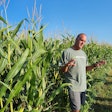
Can crickets do double duty as a protein source for feed as well as reducing mycotoxins from raw materials?
One recent study by the U.S. Department of Agriculture’s (USDA) Agricultural Research Service (ARS) looked at the possibility of using mycotoxin-contaminated grain to feed crickets.
Ryan Paulk, lead author of the study, explored the effects of fumonisin on crickets to see if they could consume contaminated grain without harm.
“If the crickets can feed on contaminated grain, and nothing happens to them, then that contaminated grain doesn’t have to go to waste,” Paulk told Entomology Today. “There has to be a way to keep that byproduct in the circular economy and get it used somewhere.”
Because corn contaminated with high levels of mycotoxins cannot be used to feed livestock, it is often diverted for use in ethanol production. If the spent grains from the ethanol production process have low enough toxin levels, it can be used in feed. But, if the toxin levels are still high, the spent grains are discarded. Paulk said including crickets in this cycle can reduce the amount of waste created.
“Finding safe alternatives to the destruction and waste of contaminated grain and restoring its economic value is needed for a sustainable future,” the paper said. “Safe reintroduction into the farm food web may be possible through a consumable intermediary such as insects.”
The study found that feeding house crickets (Acheta domesticus L.) corn-based diets contaminated with fumonisin B1 had no adverse effect on the survivorship or growth of the insects. In fact, insect meal prepared from the crickets had significantly lower levels of fumonisin than their diets did, while the frass did not differ significantly from the diet.
“It was encouraging to see mortality rates were not affected by the mycotoxin,” Paulk said in Entomology Today. “The mycotoxins go straight through the cricket, and that seems to be the case for a lot of insects. There’s immediate excretion of fumonisin, and there doesn’t seem to be any metabolizing or breaking down of fumonisin, either. The fumonisin was found primarily in their frass.”
The study’s findings support “the idea that more sustainable agricultural practices can be developed through remediation of low-value mycotoxin-contaminated grain with safer, higher-value insects as livestock feed components,” the paper said.
The idea of using insects to upcycle foodstuffs and raw materials that would otherwise go to waste has grown a lot in recent years, and it’s fascinating to watch the industry come up with new and inventive ways to upcycle more and in better ways.
“If we can reduce waste from agricultural systems and create another ingredient in animal feed at the same time, that’s a win in my book,” Paulk said.
As I said in my previous blog, circularity is one of my favorite topics, so I have to say, I wholeheartedly agree with Paulk.
















